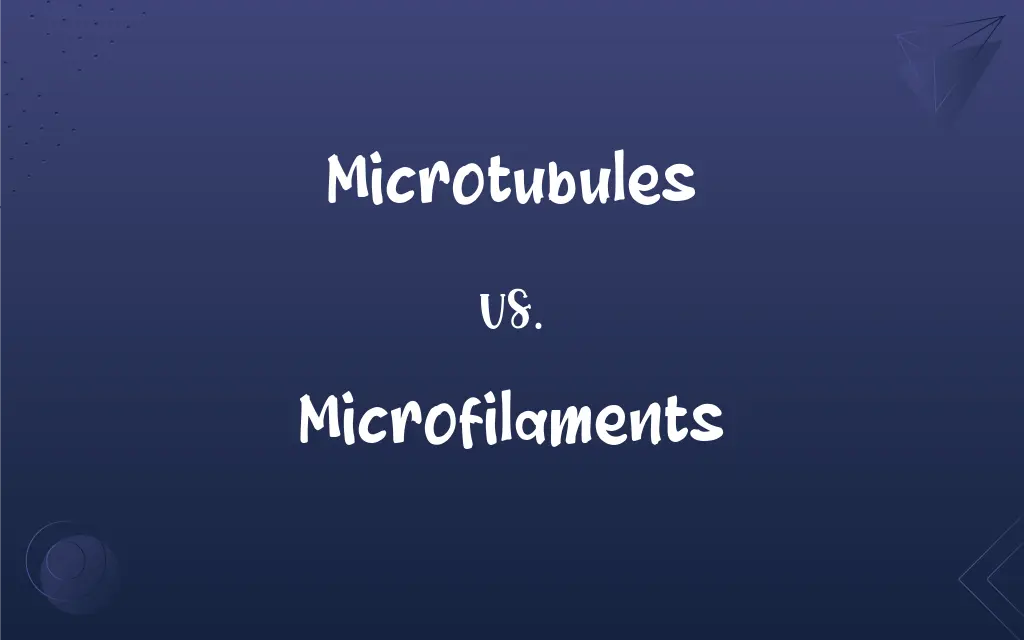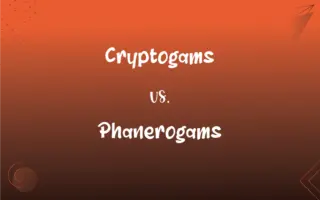Microtubules vs. Microfilaments: What's the Difference?
Edited by Aimie Carlson || By Harlon Moss || Updated on October 20, 2023
Microtubules are cylindrical tubes made of tubulin proteins, while microfilaments are thin filaments composed of actin proteins.

Key Differences
Microtubules are hollow, cylindrical structures that are integral components of the cytoskeleton in eukaryotic cells. Microfilaments, conversely, are solid, thin structures also part of the cytoskeleton.
The primary protein that makes up microtubules is tubulin, forming a tube-like structure. Microfilaments are primarily composed of actin proteins, creating a double helical structure.
Microtubules play crucial roles in intracellular transport, cell division, and maintaining cell shape. Microfilaments are involved in muscle contraction, cell division, and cell motility.
In cell division, microtubules form the mitotic spindle that helps segregate chromosomes. Microfilaments play a role in the process of cytokinesis, where the cell pinches in two.
Microtubules can rapidly assemble and disassemble, a property vital for their functions. Microfilaments, while also dynamic, are often associated with the cell's cortex, providing structural support.
ADVERTISEMENT
Comparison Chart
Composition
Made of tubulin proteins
Made of actin proteins
Structure
Hollow, cylindrical tubes
Solid, thin filaments
Function
Intracellular transport, cell division
Muscle contraction, cell motility
Role in Division
Form the mitotic spindle
Involved in cytokinesis
Dynamics
Rapid assembly and disassembly
Dynamic but provide structural support
ADVERTISEMENT
Microtubules and Microfilaments Definitions
Microtubules
Made primarily of tubulin.
Alterations in tubulin can affect microtubule stability.
Microfilaments
Key players in muscle contraction.
Actin microfilaments interact with myosin for muscle movement.
Microtubules
Essential for cell division.
During mitosis, microtubules help separate chromosomes.
Microfilaments
Vital for cell motility.
Microfilaments allow cells to move in response to stimuli.
Microtubules
Involved in intracellular transport.
Vesicles move along microtubules to their destinations.
Microfilaments
Thin actin filaments in the cytoskeleton.
Microfilaments give strength to the cell's cortex.
Microtubules
Support cell shape.
Without microtubules, cells would lose their structural rigidity.
Microfilaments
Contribute to cell division.
Microfilaments are crucial during the cytokinesis phase.
Microtubules
Hollow tubes in the cytoskeleton.
Microtubules provide pathways for motor proteins to carry cellular cargo.
Microfilaments
Provide structural support.
Microfilaments help maintain cell shape and integrity.
Microtubules
Any of the cylindrical hollow tubulin-containing structures that are found in the cytoplasm, cilia, and flagella of eukaryotic cells and are involved in determining cell shape and structure and directing the movement of organelles and chromosomes. Microtubules, along with microfilaments and intermediate filaments, make up a cell's cytoskeleton.
Microfilaments
Any of the actin-containing filaments that are found in the cytoplasm of eukaryotic cells and are involved in generating cell movement, providing structural support, and organizing internal cell components. Microfilaments, along with intermediate filaments and microtubules, make up a cell's cytoskeleton.
Microtubules
Plural of microtubule
Microfilaments
Plural of microfilament
FAQs
How are microfilaments involved in muscle contraction?
Microfilaments interact with myosin proteins, facilitating muscle contraction.
What are microtubules?
Microtubules are hollow, cylindrical structures made of tubulin proteins, part of the cytoskeleton in eukaryotic cells.
What protein primarily composes microtubules?
Microtubules are primarily composed of tubulin proteins.
What are microfilaments?
Microfilaments are solid, thin filaments primarily made of actin proteins, also part of the eukaryotic cytoskeleton.
What role do microfilaments play in cell division?
Microfilaments play a key role in cytokinesis, the process where the cell pinches in two after division.
Are microtubules and microfilaments only present in animal cells?
No, both microtubules and microfilaments are found in both plant and animal cells, but their distribution and function might vary.
How do microtubules affect cell shape?
Microtubules provide structural support, helping maintain cell shape and rigidity.
How do microtubules relate to cilia and flagella?
Microtubules are structural components of cilia and flagella, aiding in their movement.
Why are microtubules important for intracellular transport?
Microtubules serve as pathways for motor proteins to transport cellular cargo.
How do microfilaments contribute to cell movement?
Microfilaments facilitate cell motility by undergoing dynamic changes and interactions with other proteins.
Are microfilaments involved in intracellular transport?
While microtubules play a primary role in transport, microfilaments can also assist in some transport processes.
How are microfilaments implicated in cell adhesion?
Microfilaments connect to structures like focal adhesions, aiding in cell adhesion to substrates.
How are microtubules and microfilaments implicated in diseases?
Both structures, when disrupted or mutated, can lead to diseases like neurodegenerative disorders or muscular dystrophies.
How do microtubules assist in cell division?
Microtubules form the mitotic spindle, helping in chromosome segregation during cell division.
What protein primarily composes microfilaments?
Microfilaments are primarily made up of actin proteins.
Can microtubules assemble and disassemble quickly?
Yes, microtubules have dynamic properties, allowing rapid assembly and disassembly.
Are microtubules and microfilaments visible under a light microscope?
They are typically too thin to be clearly seen under a light microscope but can be visualized using electron microscopy.
Do microtubules and microfilaments interact with each other?
Yes, microtubules and microfilaments can interact, especially during cell movement and division.
What drugs target microtubules in cancer treatment?
Drugs like taxol stabilize microtubules, disrupting cell division in cancer cells.
Where are microfilaments typically found in the cell?
Microfilaments are often associated with the cell's cortex and provide structural support.
About Author
Written by
Harlon MossHarlon is a seasoned quality moderator and accomplished content writer for Difference Wiki. An alumnus of the prestigious University of California, he earned his degree in Computer Science. Leveraging his academic background, Harlon brings a meticulous and informed perspective to his work, ensuring content accuracy and excellence.
Edited by
Aimie CarlsonAimie Carlson, holding a master's degree in English literature, is a fervent English language enthusiast. She lends her writing talents to Difference Wiki, a prominent website that specializes in comparisons, offering readers insightful analyses that both captivate and inform.
































































